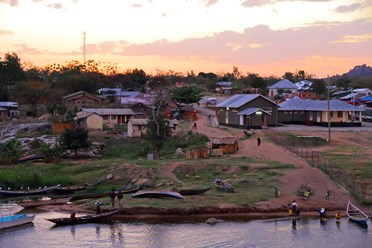 Africa has three of the top ten lakes on the planet, they are located in the southern part of the Rift Valley, in an area of ancient volcanic activity.
Africa has three of the top ten lakes on the planet, they are located in the southern part of the Rift Valley, in an area of ancient volcanic activity.Unlike the other narrow and tapered basins, Lake Victoria has a more regular shape and is divided, like Tanganyika and Malawi, among several countries.
There are also several saline, alkaline and/or seasonal lakes, which have considerable variations in their surface in relation to rainfall and their geographical location; among these, Lake Chad has undergone a drastic reduction, passing from 25,300 in 1963 to an average of only 1,350 in the current period.
| Lake | Area (km▓) |
Area (sq mi) |
Country |
| Victoria (1) | 68,800 | 26,564 | Kenya, Tanzania, Uganda |
| Tanganyika (2) | 32,893 | 12,700 | Democratic Republic of the Congo, Burundi, Tanzania, Zambia |
| Malawi (3) | 30,044 | 11,600 | Malawi, Mozambique, Tanzania |
| Makgadikgadi (4) | 16,000 | 6,178 | Botswana |
| Chott Melrhir (5) | 6,700 | 2,587 | Algeria |
| Turkana (6) | 6,405 | 2,473 | Ethiopia, Kenya |
| Albert | 5,300 | 2,046 | Democratic Republic of the Congo, Uganda |
| Mweru | 5,120 | 1,977 | Democratic Republic of the Congo, Zambia |
| Chott el-JÚrid (7) | 5,000 | 1,931 | Tunisia |
| Etosha Pan (8) | 4,800 | 1,853 | Namibia |
| Tana (9) | 3,250 | 1,255 | Ethiopia |
| Bangweulu (10) | 3,000 | 1,158 | Zambia |
| Rukwa | 2,800 | 1,081 | Tanzania |
| Kivu | 2,700 | 1,042 | Democratic Republic of the Congo, Rwanda |
| Chilwa | 2,600 | 1,004 | Malawi, Mozambique |
| Edward | 2,325 | 898 | Democratic Republic of the Congo, Uganda |
| Chott Ech Chergui (11) | 2,000 | 772 | Algeria |
| Chad (12) | 1,540 | 595 | Cameroon, Chad |
| Mweru Wantipa | 1,500 | 579 | Zambia |
| Manzala | 1,360 | 525 | Egypt |
| Abaya | 1,160 | 448 | Ethiopia |
| Eyasi (13) | 1,000 | 386 | Tanzania |
* artificial reservoirs are excluded; for saline or seasonal lakes, the maximum surface area is indicated, unless otherwise specified
(1) Third largest lake in the world after the Caspian Sea and Lake Superior.
(2) Second deepest lake on the planet after Baikal (1,470 meters).
(3) Also known as Niassa, it is the lake that hosts the largest number of fish species in the world.
(4) Maximum area reached only in the peak of the rainy season, otherwise it is largely dry.
(5) Salt lake and usually mostly dry, which rarely and for a short time reaches the shown area.
(6) The largest alkaline lake and permanent desert lake in the world.
(7) Maximum area, reached only in periods of more intense precipitation.
(8) Non-permanent basin that is sometimes created during the rainy season.
(9) Its surface varies according to the season between 3,000 and 3,500 km▓.
(10) During the rainy season it can reach up to about 15,000 km▓.
(11) Salty basin and for most of the year almost completely dry.
(12) Average area in 2020, after more than 90% of the lake has dried up (it was 25,300 km▓ in 1963).
(13) Salty alkaline lake, with variable surface area depending on the season.
